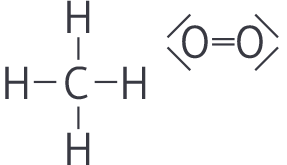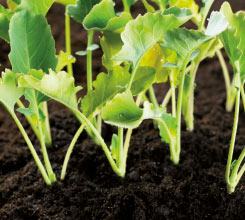The world of the
REMONDIS Lippe Plant
Nature’s way of recycling is always best – which is why we do exactly the same. By transforming biodegradable kitchen and garden waste into high quality compost, we are helping to promote sustainable, healthy growth. In small gardens and on large farms.

A two-way system
Output fractions
From wood chip fuel to top quality compost.
Fertile soils
Composts promote sustainable, environmentally friendly farming methods and help preserve finite resources.

Teamwork

Earthworks
Find out all about the new plant’s two-way system
Recycling never stands still – on the contrary, it is constantly moving forward and being further developed. An excellent example of this can be seen at the composting plant at the Lippe Plant. As part of a major project, the site’s organic material treatment facility was converted from the so-called Brikollare system to a highly efficient plant that enables the input material to be recycled for reuse as well as to generate energy. At the heart of this new facility is – besides a tunnel reactor – a modern digester, which transforms organic materials into methane. In other words, a particularly environmentally friendly and sustainable source of energy.

Organic material is transformed into high quality compost or biogas at the Lippe Plant
The facility: a few facts & figures

Just as was the case in the old facility, the material is kept in fully enclosed halls with modern biofilter and air scrubber systems throughout the whole of the treatment process. The air is continuously vacuumed off and cleaned. Other interesting facts about the composting plant’s processes and what happens inside the facility can be found below.

REMONDIS’ subsidiary, RETERRA, has been operating a digester in Coesfeld – just like the one at the new composting plant – for many years now
The all-important word when it comes to the treatment of organic material at the Lippe Plant is “cascaded use”. This means that the organic materials are recycled at various different levels, all of which are linked to one another. This ensures that as many input materials as possible are used sustainably. What can’t be fermented and transformed into biogas is still an excellent substance for compost – as is the digestate (the residue left over after the fermentation process). These two recycling methods are known as anaerobic and aerobic treatment. The first – the fermentation in the digester with completely new machine technology – works without a supply of oxygen; the second – the composting in the tunnels – with a supply of oxygen.
How the anaerobic treatment works in the digester

01
Once the organic material has been shredded, screened and freed of contaminants, it is placed in the digester. This is the name given to the bioreactor, in which the fermentation process takes place.

02
The material remains in the hermetically sealed digester for 14-21 days. During this time, microorganisms transform the organic material into methane.

03
Once this stage has been completed, the methane – also known as biogas – is piped to the combined heat and power plant (also at the Lippe Plant) where it is converted into electricity.

04
The amount of electricity produced can be increased and decreased as required.
How the aerobic treatment works in the composting tunnels

01
Low-energy digestate from the digester and organic material are placed in the composting tunnel. This is a dark, tubular space in which the old air is continuously being removed and fresh air added.

02
The biological reaction between the different materials creates heat which facilitates the drying process.

03
The composting process in the tunnel takes approximately three weeks. During this time, both microorganisms and the constant supply of oxygen transform the material into compost.

04
Once completed, the material is freed of contaminants such as metals, stones, glass and plastics before being stored for collection. This material is now premium, quality-assured compost.
Only material that has a particle size of less than 12 millimetres officially passes as compost. This is a high quality fine compost that is stored as a loose material and can be collected by customers. The material has to undergo the composting process several times before it actually reaches this quality. Output material with medium-sized particles (12–45mm) and coarse-sized particles (>45mm) is returned to the beginning – provided that it doesn’t contain too many contaminants – and added to the incoming material. It plays an important role here. The freshly delivered material is often too wet and lacks the required structure for the process. Adding the processed output material helps counteract this problem.
Turning coarse into fine – sooner or later


Nothing is wasted: we can even use the excess quantities from the screening process; these are sent to the Lippe Plant’s own biomass-fired power station where it is transformed into electricity
Find out more about the different products at reterra.de (German)
The composts produced at the Lippe Plant are marketed across the country under the brand name, HUMERRA. This range consists of products of different qualities and for diverse applications. For example as fine compost, structured compost, substrate compost and active compost. However, we don’t only produce composts at the composting plant. We also make woodchips from woody materials, such as tree trunks and roots from landscape maintenance work. This ensures that even the material that can’t be used in the digester or to make compost can be put to sustainable use. We sell these woodchips under the Pyrohack brand name, primarily to biomass-fired power stations in Germany.

The HUMERRA products are produced and sold by RETERRA – a company belonging to the REMONDIS Group
Did you know that removing the contaminants from the incoming organic material makes up 30 percent of the overall processing costs? Your initial reaction may be to think that this is simply an economic issue. It is, however, much more than this. It also shows how carelessly and thoughtlessly we treat this valuable resource. The same is true here as with all other recycling systems: the successful processing of recyclables does not begin at the recycling plants but with each individual person in their homes. The better the garden waste and other types of organic waste are sorted at source, the greater the chance that it can be treated efficiently. In other words: material that contains large volumes of contaminants – waste plastic and packaging are the biggest problem here – is often unable to be recycled. Either because the sorting technology needed for such cases would be too expensive or because it is simply not possible to separate the materials from each other. This has a negative impact on both humans and the environment. Why? Because if organic material is not recycled sustainably, then the result is less environmentally friendly biogas and less resource conservation.

Separating organic material from other waste streams enables it to be recycled, helping to conserve our planet’s natural resources
Plastic has no business being in the composting plant – but it has in the Lippe Plant. Find out all about our plastics recycling operations
Every gardener knows that plants grow better when compost is added to the soil. What is more important, however, is what compost achieves for the agricultural sector – helping to guarantee food supplies all around the world. Compost, for example, improves the soil’s ability to absorb and store large volumes of water. Experts refer to the first as a soil’s infiltration rate and the second as its water retention behaviour. Both parameters play a crucial role in determining the fertility of soil. And the more fertile the soil, the greater the crop yield. Certainly an important aspect as the world’s population approaches the 10-billion mark.

Using compost improves farming land and increases crop yields
We are having to face a serious phenomenon in Germany, as does everyone else around the world: soil sealing. This is when soil is covered with waterproof material or structures, such as buildings or tarmac, and is no longer able to absorb rainwater – something that is happening more and more. It is, however, essential that rainwater is absorbed in order to refill groundwater supplies. Consequently, the most needs to be made of the farming land in the areas where arable soil is being covered over in order to ensure it absorbs as much rainwater as possible. Compost can also play a vital role here as it helps improve a soil’s infiltration rate.
The Lippe Plant also has an earthworks as well as a composting plant. This is where we make arable soils from earth, cleaned grit chamber contents and aggregate such as volcanic rock flour. The plant, earth, soil and rock substrates produced at the Lippe Plant are used, for example, for turning brownfield areas into green spaces or for landscaping work. These substrates are produced on an impressive scale. The earthworks’ current permit allows it to produce 50,000 tonnes of earth substrate and biogenic fuel every year.


Turf-substitute products are also made at the earthworks. They, of course, help preserve our moorlands where the turf is so important for storing CO2

Diese Seite verwendet aktuelle Techniken, die in dem von Ihnen verwendeten Browser unter Umständen nicht korrekt
angezeigt werden können.
Bitte aktualisieren Sie Ihren Internet-Explorer oder weichen auf einen anderen Browser wie Chrome oder
Firefox aus.
Schließen